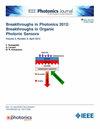Laser Phase Noise Tolerant and Power-Fading-Free Hybrid Fiber-Wireless Double-Sideband Transmission With Spectral Efficiency Enhancement
IF 2.1
4区 工程技术
Q3 ENGINEERING, ELECTRICAL & ELECTRONIC
引用次数: 0
Abstract
The photonics-assisted millimeter-wave (MMW) communication technology is attractive to facilitate the MMW application in the upcoming B5G and 6G networks. However, its generated MMW signal by optical heterodyne detection usually suffers from serious laser phase noise, which will severely deteriorate the system performance. In this paper, based on a single dual-drive Mach-Zehnder modulator and a single-end photodetector, we first present a simple and spectrally efficient hybrid fiber-wireless double-sideband transmission by employing an overlapping frequency multiplexing scheme. That is, two independent wireless signals with an identical carrier frequency can be simultaneously transmitted in the hybrid fiber-wireless links. To recover the above two overlapped signals, and cancel the concomitant laser phase noise at the same time, a novel digital signal processing method for carrier extraction and signal recovery is further proposed. A proof-of-concept experiment using two independent 3-GBd quadrature phase shift keying (QPSK) signals at W band (92.5 GHz) is performed. After up to 80-km fiber and 3-m wireless transmission, the two QPSK signals can be successfully demodulated, without using the traditional carrier phase estimation algorithm. The proposed scheme not only can double the spectral efficiency of conventional double sideband transmission scheme, but also is immune to its power fading phenomenon induced by chromatic dispersion and robust to the laser phase noise resulting from two free-running lasers in the photonics-assisted MMW communication link.提高光谱效率的激光相位噪声容限和无功率衰减混合光纤-无线双侧带传输技术
光子辅助毫米波(MMW)通信技术对于促进毫米波在即将到来的 B5G 和 6G 网络中的应用极具吸引力。然而,其通过光外差探测产生的毫米波信号通常存在严重的激光相位噪声,这将严重降低系统性能。本文首先基于一个双驱动马赫-泽恩德调制器和一个单端光电探测器,采用重叠频率复用方案,提出了一种简单且光谱效率高的混合光纤-无线双侧带传输方式。也就是说,在混合光纤-无线链路中可以同时传输两个载频相同的独立无线信号。为了恢复上述两个重叠信号,同时消除伴随的激光相位噪声,进一步提出了一种用于载波提取和信号恢复的新型数字信号处理方法。在 W 波段(92.5 GHz)使用两个独立的 3GBd 正交相移键控(QPSK)信号进行了概念验证实验。经过长达 80 千米的光纤和 3 米的无线传输后,无需使用传统的载波相位估计算法,两个 QPSK 信号即可成功解调。所提出的方案不仅能将传统双侧带传输方案的频谱效率提高一倍,而且还能抵御色度色散引起的功率衰减现象,并对光子辅助 MMW 通信链路中两个自由运行激光器产生的激光相位噪声具有鲁棒性。
本文章由计算机程序翻译,如有差异,请以英文原文为准。
求助全文
约1分钟内获得全文
求助全文
来源期刊

IEEE Photonics Journal
ENGINEERING, ELECTRICAL & ELECTRONIC-OPTICS
CiteScore
4.50
自引率
8.30%
发文量
489
审稿时长
1.4 months
期刊介绍:
Breakthroughs in the generation of light and in its control and utilization have given rise to the field of Photonics, a rapidly expanding area of science and technology with major technological and economic impact. Photonics integrates quantum electronics and optics to accelerate progress in the generation of novel photon sources and in their utilization in emerging applications at the micro and nano scales spanning from the far-infrared/THz to the x-ray region of the electromagnetic spectrum. IEEE Photonics Journal is an online-only journal dedicated to the rapid disclosure of top-quality peer-reviewed research at the forefront of all areas of photonics. Contributions addressing issues ranging from fundamental understanding to emerging technologies and applications are within the scope of the Journal. The Journal includes topics in: Photon sources from far infrared to X-rays, Photonics materials and engineered photonic structures, Integrated optics and optoelectronic, Ultrafast, attosecond, high field and short wavelength photonics, Biophotonics, including DNA photonics, Nanophotonics, Magnetophotonics, Fundamentals of light propagation and interaction; nonlinear effects, Optical data storage, Fiber optics and optical communications devices, systems, and technologies, Micro Opto Electro Mechanical Systems (MOEMS), Microwave photonics, Optical Sensors.
 求助内容:
求助内容: 应助结果提醒方式:
应助结果提醒方式:


